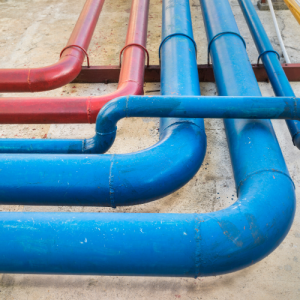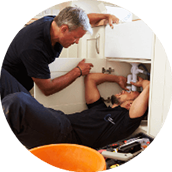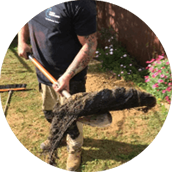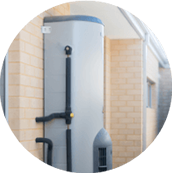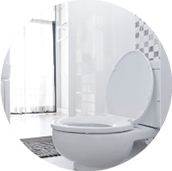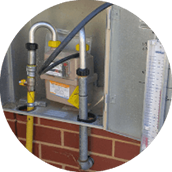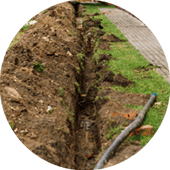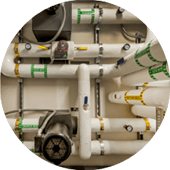There are three main types of plumbing systems which are installed within a building. Potable, sanitary and stormwater systems are the main three all have their own purposes. All residential, commercial and industrial buildings have each plumbing system installed. Here at Optimised Plumbing Services, our Emergency Plumber services have us working on any plumbing system across of all Sydney.The three main types of plumbing systems include potable, sanitary and stormwater. Each system has its main function but ultimately brings water to a building and removes it and waste from it. Potable brings in water, sanitary removes wastage and stormwater transfers rainwater from the building.
Potable Plumbing Systems
A potable water system is responsible for bringing in water from local community water mains into a building. A water valve on the water main is there so the water can be shut off if needed. Similarly, a water meter is installed to keep a record of how much water is used in the building. For more information on water meters and how they are used in Sydney, visit Sydney Water.The potable system transfers water that is used for drinking, cleaning and alike, meaning it is safe for people. In the specific building, there are various different pipes and fixtures which are used to divert water to each appliance. These include:
- Straight Pipes – these are the more common pipes in the potable plumbing system. Either long or short, the straight pipes quickly direct water to where it needs to be.
- Tee Section – the shape of these are of a right-angle.
- Elbows – these are used for directional changes in the plumbing system.
- Brass and Gate Valves – controlling the flow of water is the main function of these appliances.
Sanitary Plumbing Systems
The sanitary plumbing systems are what remove all wastage from a building. This wastage includes human wastage and wastewater, such as from cooking and washing. Furthermore, the wastage is transferred to the local community sewage. They are connected on the ceiling to ventilate gases and allows the system to work at atmospheric pressures. With sanitary plumbing systems, there are three main types which can be installed:
- Gravity Systems – The more common type of sanitary system are the gravity systems. Using the natural slope of the ground, these easily collect the wastewater and bring it to the sewage network. Also, these are used mainly in places where flooding is not common and where the water table is relatively low.
- Low Pressure Systems – These are a low-head pressure system which is an alternative to the gravity system. An interceptor tank with a chamber unit is within the system which holds a small electrical pump. Installed belowground, the waste is transported to the main sewage plant by using small pressure lines.
- Vacuum Systems – Another alternative to gravity systems, this system uses electricity and are mainly installed in specific areas. These include areas that have reclaimed ground, charged ground, seasonal areas or in flat areas. Using a central vacuum station, the sewage fittings are connected through vacuum valves. Also, the central vacuum station has vacuum pumps, discharge pumps, a collection chamber and associated controls.
Stormwater Plumbing Systems
The main function of the stormwater plumbing systems is to have rainwater removed from the building. They are installed with specific characteristics to ensure that the water it successfully transferred away. The water can be collected and travelled away from the following:
- Roof – The roof is designed to ensure that the water travels down into the pipes and removed from the area. Depending on how much rainfall is received, the design and the size of the downpipes and roof will be influenced.
- Surface – Paved or unpaved areas have the water from remaining there removed through the angle of the surface. Adjacent drains can be included, but the water should be transferred away before pooling up quickly on the flat surface.
- Subsoil – In regards to water that is trapped below ground, subsoil drains are needed. These underground drains collect the stormwater to then go to a drain before it runs-off to other properties and alike. For more information on what a subsoil drain is, visit our blog with greater detailed information.
With transferring the water away, there are a few systems which then transport the water to the next point, including:
- Gravity-Fed Systems – Pipes are angled in a way so that the water can go straight down through the drainage systems. The size of the pipes is determined from the amount/ intensity of rainfall and the size of the area.
- Pump-Based Systems – When the slope of the land is not suitable for gravity-fed systems then pumps may be needed. These often incorporate rainwater tanks and also pump the water where it needs to go.
- Stormwater Discharge and Harvesting – Larger pipes and channels may be installed to transport water to local rivers, lakes the sea. Mainly in more populated areas, however, this type of system often leads to pollution going into the native waterways.
Sydney Emergency Plumbing System Workers
Optimised Plumbing Services has been handling plumbing issues and solving the problems for over 15 years. Our emergency plumbers are fully licensed plumbers who are available 24/7 to all Sydney residents and workers. Working as emergency plumbers in Sydney, our team can operate in both residential and commercial plumbing. Our plumbing work, as well, is always professional completed no matter the installation or repair.In regards to the different plumbing systems, we can effectively perform any needed installation or repair needed. No matter if it is day or night, we provide the best customer service when it comes with working on plumbing systems. We have the best plumbing solutions with any plumbing problem, like Blocked Drains. Furthermore, we know the most efficient ways to install every plumbing system. We can work on any plumbing system in any location within Sydney, including the Eastern Suburbs and the North Shore. Guaranteed the best plumbing performance in Sydney – call us on 02 8074 1475 or email us at contact@optimisedplumbingservices.com.au. We will arrive quickly to ensure that all jobs related to plumbing systems are handled with professional hands.

